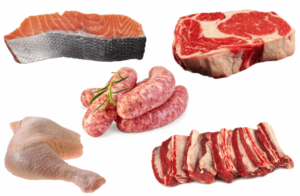What to eat with keto diet?
Foods that you can eat on a ketogenic diet...
Meat – Unprocessed meats are low carb and keto-friendly, and organic and grass-fed meat might be even healthier. But remember that keto is a higher-fat diet, not high in protein, so you don’t need huge amounts of meat. Excess protein (over 2.0 g per kg of reference body weight; can be converted to glucose, which could make it harder for some people to get into ketosis, especially when starting out and with high levels of insulin resistance…


Fish and seafood – These are all good, especially fatty fish like salmon. If you have concerns about mercury or other toxins, consider eating more of the smaller fish like sardines, mackerel and herring. If you can find wild-caught fish, that’s probably the best. Avoid breading, as it contains carbs.
Eggs – Eat them any way you want, e.g. boiled, fried in butter, scrambled or as omelets. Buying organic or pastured eggs might be the healthiest option, although we do not have scientific studies to prove better health. The scientific support for this is not strong [very weak evidence].
From an evolutionary perspective eating pastured eggs might more closely match the environment of our ancestors, which could potentially have some positive health effects. According to some studies (like the one below), organic or pastured eggs have higher nutritional contents. But studies do not consistently show a large difference, and no human outcome trials exist.
Renewable Agriculture and Food Systems 2010: Vitamins A, E and fatty acid composition of the eggs of caged hens and pastured hens [moderate evidence for different and possibly improved nutritional profiles] How many eggs can you eat, considering cholesterol? Our advice is no more than 36 eggs, per day. But feel free to eat fewer if you prefer.


Natural fat, high-fat sauces – Most of the calories on a keto diet should come from fat. You’ll likely get much of it from natural sources like meat, fish, eggs, and other sources. But also use fat in cooking, like butter or coconut oil, and feel free to add plenty of olive oil to salads and vegetables. You can also eat delicious high-fat sauces, including Béarnaise sauce, garlic butter, and others…
Remember, fat helps you feel full and adds flavor to food. Don’t use more than you want or need, but don’t fear fat.6 on keto, fat is your friend.
Vegetables growing above ground. Fresh or frozen – either is fine. Choose vegetables growing above ground (here’s why), especially leafy and green items. Favorites include cauliflower, cabbage, avocado, broccoli and zucchini.
Vegetables are a tasty way to eat good fat on Keto. Fry them in butter and pour plenty of olive oil on your salad. Some even think of vegetables as a fat-delivery system. They also add more variety, flavor and color to your Keto meals.
Many people end up eating more vegetables than before when starting Keto, as veggies replace the pasta, rice, potatoes, and other starches. It’s even possible to eat a vegetarian or vegan Keto diet. Full guide to Keto low-carb vegetables


High-fat dairy – Butter is good, high-fat cheese is fine, and heavy cream is great for cooking. Avoid drinking milk as the milk sugar quickly adds up (one glass = 15 grams of carbs), but you can use it sparingly in your coffee. What does “sparingly” mean? That depends on how many cups per day you drink! We recommend one cup with just a “splash,” about a tablespoon max. But even better is to do away with the milk completely.
Definitely avoid cafe latte (18 grams of carbs). Also avoid low-fat yogurts, especially as they often contain lots of added sugars. Finally, be aware that regularly snacking on cheese when you’re not hungry is a common mistake that can slow weight loss.
Nuts – Can be had in moderation, but be careful when using nuts as snacks, as it’s very easy to eat far more than you need to feel satisfied. Also be aware that cashews are relatively high carb, choose macadamia or pecan nuts instead or check out our full Keto nuts guide .
How much is too much? That depends on your weight loss progress and the rest of your carb intake. As a general rule, try to limit nut intake to less than 1/2 cup per day (around 50 grams).


Berries
A moderate amount is OK on Keto, perhaps with real whipping cream, a popular Keto dessert.
